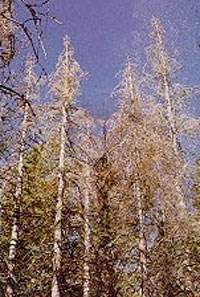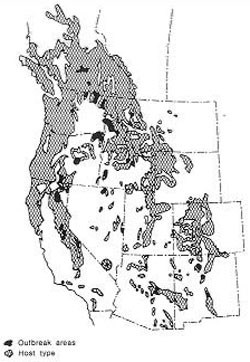

What is the Douglas fir tussock moth and what does it do?The Douglas fir tussock moth is a native insect of Yosemite and the rest of the Sierra Nevada. It is during the larvae or caterpillar phase of this insect’s life cycle when it eats the needles from the trees. The distinctive caterpillar can be readily identified by its four “tussocks,” the line of buff-colored tufts that runs along its back. It feeds primarily on white fir in the Sierra forests. Historically, Douglas-fir tussock moths have had wildly fluctuating populations punctuated by irruptions (sudden upsurges in numbers) and massive die-offs from natural causes—particularly a virus that is always present in the soil and that affects only them. Yosemite foresters detected an increase in 2002 that lasted until 2006. Visitors may still notice in the Chinquapin and Crane Flat areas of Yosemite may notice thin foliage, snag tops, and dead white fir trees in the forest. This is evidence of a recent outbreak of Douglas-fir tussock moth caterpillars. Over the course of about three years, tussock moth caterpillars defoliated almost 16,000 acres of white fir forests before the naturally-occurring virus that commonly controls their outbreaks spread widely enough to return populations to background levels. While this may look like an unhealthy forest, it is actually part of a natural process that thins out dense trees, provides habitat for birds, insects and squirrels in dead trees, and fertilizes the soil. How Does the Douglas fir Tussock Moth Kill Trees?Douglas fir tussock moths are defoliators—they eat the leaves off of plants. More precisely, immature caterpillars climb to the top of the tree or building where they hatched, spin a silk web to sail on, float on the wind until they land, and eat any leaves they can find. If they land and find fresh white fir needles to eat, they will grow larger, eventually eating all of the needles from a branch. If there are enough caterpillars to eat all of the needles from most branches of an entire tree, that tree cannot make any food, may not have stored reserves to grow buds for the next year, and becomes very susceptible to secondary insects including fir engraver beetles. Trees that have been mostly defoliated will die. Almost all trees that are defoliated two years in a row will die. 
U.S. Forest Service What Effect Does It Have on Humans?The hairs on the caterpillars as well as their egg masses and cocoons may cause allergic reactions in some people. Itching is the most common complaint, but adverse health effects can include rashes (with welts or blisters), watery eyes, runny nose, cough and, less commonly, shortness of breath, wheezing, and chest tightness. Hot weather and perspiration increase the severity of symptoms, and people with a history of allergies may be more susceptible to “tussockosis.” Accidental disturbance or handling of old larval skins and spent cocoons, deposited under leaf litter, bark, wood piles, timber, or any other material that caterpillars have touched, can result in irritation. Irritation intensity depends upon the amount of contact with the caterpillar and the sensitivity of the person. The effects may be cumulative, with successive exposures resulting in elevated symptoms. In a 1998 outbreak at Grant Grove (located in Kings Canyon National Park), approximately 100 people sought medical attention or advice and facilities were closed for health and safety reasons. Is a Tussock Moth Outbreak Bad for the Forest?While this natural process might look “bad,” the forests are actually 7 times more dense than normal for white fir forests due to the absence of fire. Because of fire suppression, these forests went without fire for more than 5 times the naturally-occurring fire cycle. The Douglas fir tussock moth actually helps to bring the tree density and species composition of the forests back toward the natural range. Other disturbance agents like bark beetles, mistletoe, wind, snow, and fire may also reduce tree density, while seeding and growth continue. How Did Yosemite Monitor and Manage the Douglas fir Tussock Moth Outbreak?Douglas fir tussock moth (DFTM) population increases were first detected through traps set in cooperation with West-wide DFTM Early Warning Pheromone Detection Survey in 2002. By 2003 the USDA Forest Service Forest Entomologist in Sonora observed defoliation around Crane Flat. In 2005 defoliation was apparent around Crane Flat, Chinquapin, South Entrance, and the Mariposa Grove of Giant Sequoias, as well as on the adjacent Stanislaus and Sierra National Forests and on private forest land near South Entrance. Over 10,000 acres of defoliated white fir was mapped during the annual Forest Health Management aerial survey of Yosemite. At the end of the 2005 season, more than 3,000 eggs were collected and sent to the Canadian laboratory of Douglas fir tussock moth expert Dr. Imre Otvos. Larvae emerged from nearly 80% of the eggs in the laboratory. Yosemite park staff were concerned because it appeared that 2006 might bring a widespread outbreak that would rival or exceed the 1998 Grant Grove outbreak. In addition to the health symptoms and safety concerns in that incident, hundreds of acres of white fir trees were killed. Park managers evaluated control options for developed areas, including helicopter and ground sprays of naturally-occurring selective virus. Monitoring and warnings were eventually selected as the preferred alternative to manage the predicted outbreak. Visitors attempting to reserve spaces at Crane Flat Campground were automatically given warnings of the health concerns. In early summer of 2006, campers at Crane Flat reported over 100 caterpillars at a time around campsites. Nearly all vertical or overhanging surfaces harbored caterpillars or cocoons. Students, firefighters, utility & forestry workers, and 1 family of campers in the Crane Flat area reported skin irritations, respiratory complaints, and tussockosis symptoms. While there was at least 16,000 acres of white fir defoliation, by the end of summer, the naturally occurring virus that effects Douglas fir tussock moths set the adult moth counts back below advisory levels in 8 of the 10 Yosemite transects. In 2007, removal of the dead and hazardous fir trees began along roads and near developed facilities where people could be struck by tree failures. Removal of dead and hazardous trees continues in the Crane Flat and Chinquapin areas. When an Where Will the Next Irruption Occur?No one can tell when and where the next Douglas fir tussock moth outbreak will occur until just a few years before it peaks. Previously recorded outbreaks in the Yosemite area have resulted in some defoliation, but before the recent irruption, no tree mortality or public health effects had been reported. Historically, virus levels in endemic populations drop enough to allow for another outbreak after 5 to 20 years. There is no single factor that triggers an outbreak, but uncertain weather trends or vegetation cover associated with global climate change could lead to more frequent or more intense irruptions of Douglas fir tussock moths in future years. |
Last updated: January 23, 2020
